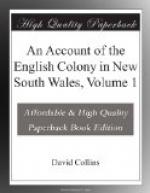For some time after their arrival at Norfolk Island they were very sullen, and as anxiously avoided giving any information respecting the flax, as our people were desirous of obtaining it. The apprehension of being obliged to work at it was afterwards found to have been a principal reason for their not complying so readily as was expected. By kind treatment, however, and indulgence in their own inclinations, they soon began to be more sociable. They were then given to understand the situation and short distance of New Zealand from Norfolk Island, and were assured that as soon as they had taught our women ‘emou-ka ea-ra-ka-ke,’ (i.e. to work the flax), they should be sent home again. On this promise they readily consented to give all the information they possessed, and which turned out to be very little. This operation was found to be among them the peculiar province of the women; and as Hoo-doo was a warrior, and Too-gee a priest, they gave the governor to understand that dressing of flax never made any part of their studies.
When they began to understand each other, Too-gee was not only very inquisitive respecting England, etc. (the situation of which, as well as that of New Zealand, Norfolk Island, and Port Jackson, he well knew how to find by means of a coloured general chart); but was also very communicative respecting his own country. Perceiving he was not thoroughly understood, he delineated a sketch of New Zealand with chalk on the floor of a room set apart for that purpose. From a comparison which Governor King made with Captain Cook’s plan of those islands, a sufficient similitude to the form of the northern island was discoverable to render this attempt an object of curiosity; and Too-gee was persuaded to describe his delineation on paper. This being done with a pencil, corrections and additions were occasionally made by him, in the course of different conversations; and the names of districts and other remarks were written from his information during the six months he remained there. According to Too-gee’s chart and information, Ea-hei-no-maue, the place of his residence, and the northern island of New Zealand, is divided into eight districts governed by their respective chiefs, and others who are subordinate to them. The largest of those districts is T’Souduckey, the inhabitants of which are in a constant state of warfare with the other tribes, in which they are sometimes joined by the people of Moo-doo When-u-a, Tettua Whoo-doo, and Wangaroa; but these tribes are oftener united with those of Choke-han-ga, Teer-a-witte, and Ho-do-doe against T’Souduckey (the bounds of which district Governor King inclines to think is from about Captain Cook’s Mount Egmont, to Cape Runaway). They are not, however, without long intervals of peace, at which times they visit, and carry on a traffic for flax and the green talc-stone, of which latter they make axes and ornaments. Toogee obstinately denied that the whole of the New Zealanders were cannibals*;




